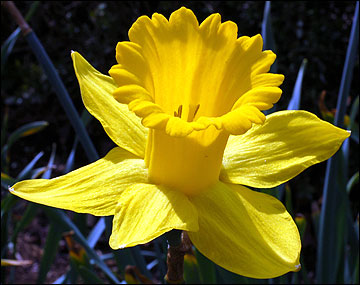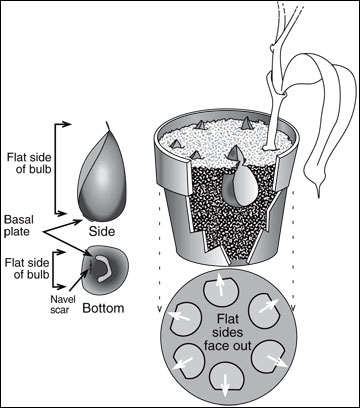Bulbs made to flower at other than normal times are said to be forced. The practice of forcing is commonly used to flower daffodils, hyacinths, tulips, crocus and other spring bulbs during the winter (Figure 1). With proper planning and care, bulbs can supply color for the home from late November until early April, when they begin to flower normally outdoors.
 Figure 1
Figure 1
Daffodils are relatively easy to force and can bring the beauty of spring indoors in winter.
Forcing bulbs in containers
Steps for forcing include selecting the most suitable varieties, potting bulbs properly in well-drained potting medium, providing proper cold-temperature treatment, bringing bulbs into a cool room, and placing the plants in a display location when well-developed.
Stage 1
Preparation
Any spring-flowering bulb can be forced, but to be successful, select types and varieties known to force well. Hyacinths and daffodils are generally the easiest to force. Tulips are slightly more difficult, but with proper treatments they can be forced successfully. Many small bulbs such as crocus, grape hyacinth and snowdrops also may be forced.
The general procedure for forcing all these bulbs is similar. Begin by buying only top-quality, flowering-size bulbs for indoor forcing. Good bulbs contain food reserves necessary for successfully producing roots, leaves and flowers.
Hyacinths
Hyacinths are usually the most easily forced spring bulbs. They may be forced in water or potted in a container. Potting should be done in late September or early October. Plants will flower about one month after being brought indoors from the chilling treatment. Earliest bloom from bulbs can be expected about mid-January.
Specially prepared, or pre-chilled, bulbs are available for forcing into bloom by Christmas. Specific directions are supplied with these bulbs if they are prepared for early forcing.
Table 1 lists hyacinth varieties most suitable for forcing, along with the appropriate potting and forcing dates.
Daffodils (Narcissus)
Many varieties of daffodils can be forced; Table 2 lists some of the more popular ones. Paperwhite Narcissus are suitable for earliest forcing either in pots or in water.
Tulips
Table 3 suggests tulip varieties suitable for forcing, but many others may be used.
All varieties should be potted before the end of October for adequate root growth and chilling. Dates listed in the table are the earliest that bulbs planted in October should be brought into forcing conditions. Most varieties flower about one month after being brought indoors, although timing varies due to varieties and individual forcing conditions.
Table 1 lists hyacinth varieties most suitable for forcing along with the appropriate potting and forcing dates.
Table 1
Hyacinth varieties for forcing
| Variety | Color | Pot no later than | Earliest date to bring indoors | |
|---|---|---|---|---|
| Early forcing | Anne Marie | bright pink | Oct. 1 | late December |
| Delft Blue | porcelain blue | Oct. 1 | late December | |
| Jan Bos | red | Oct. 1 | late December | |
| L'Innocence | white | Oct. 1 | late December | |
| Mid-season forcing | Carnegie | white | Oct. 1 | early January |
| Myosotis | pale blue | Oct. 1 | early January | |
| Ostara | dark blue | Oct. 1 | early January | |
| Pink Pearl | pink | Oct. 1 | early January | |
| Late forcing | City of Harlem | yellow | Oct. 15 | mid-February |
| King of the Blues | deep blue | Oct. 15 | mid-February | |
| Lady Derby | rose pink | Oct. 15 | late January | |
Table 2
Daffodil (Narcissus) varieties for forcing.
| Variety | Color | Forcing dates |
|---|---|---|
| Accent | white; salmon cup | March to April |
| Barrett Browning | white; orange cup | January to April |
| Bridal Crown | golden yellow | March to April |
| Carlton | double white; orange center | January to February |
| Cassata | creamy to pale yellow | January to April |
| Dutch Master | golden yellow | January to April |
| February Gold | bright yellow | January to February |
| Flower Record | white; orange-rimmed cup | January to February |
| Fortune | yellow; coppery-orange cup | January to April |
| Ice Follies | white; yellow cup | January to April |
| Las Vegas | white; lemon yellow cup | January to April |
| Mt. Hood | ivory white | January to April |
| Tete a Tete | yellow miniature | January to February |
| Unsurpassable | yellow | March to April |
Table 3
Tulip varieties for forcing.
| Variety | Color | Earliest date to bring indoors |
|---|---|---|
| Apeldoorn | orange-scarlet | early February |
| Apricot Beauty | salmon-rose | early January |
| Attilla | purple violet | mid-January |
| Bellona | golden yellow | early January |
| Blizzaard | creamy white | early February |
| Christmas Gold | deep yellow | early January |
| Christmas Marvel | cherry pink | early January |
| Couleur Cardinal | cardinal red | early February |
| DeWet (General) | orange | early January |
| First Lady | reddish-violet | early January |
| Garden Party | white-edged red | early February |
| Gudoshnik | pale yellow streaked; rose pink | early February |
| Jewel of Spring | yellow-streaked red | early February |
| Kansas | white | early January |
| Make Up | red-edged white | early February |
| Merry Widow | white-edged red | mid-January |
| Olympic Flame | yellow-flamed red | early February |
| Orange Nassau | double-orange scarlet | mid-January |
| Orange Wonder | bronzy-orange | mid-January |
| Paul Richter | scarlet red | early January |
| Peach Blossom | double deep rose | early February |
| Preludlum | salmon with white base | early January |
| Queen of Sheba | mahogany-edged orange | early February |
| Westpoint | yellow | early February |
Stage 2
Potting
Materials
The following materials will be needed for potting bulbs:
- Pots 4 to 8 inches in diameter. Short pots known as azalea or bulb pots are preferred.
- A well-drained potting medium such as a blend of Sphagnum peat, vermiculite and perlite. High fertility is not essential, but good drainage is important. No fertilizer is needed at potting time.
- Wood, plastic or metal labels.
- Thermometer for checking temperatures.
Procedure
All bulbs are normally potted in October.
- Add enough soil mixture to fill the pot so bulbs are placed as follows:
- Hyacinths and tulips: Allow only the tip of the bulb to show above the soil line.
- Daffodils: Plant so about one-half of the bulb shows above the soil line.
- Small bulbs (crocus, snowdrop, grape hyacinth, etc.): Plant so they will be about one inch below the soil line.
- Set the bulbs in the pot. One large bulb may be placed in each 4-inch pot. Use six tulips, three hyacinths, five daffodils or 15 crocuses (or other small bulbs) in each 6-inch pot. All bulbs in a pot should be of the same kind and variety to ensure uniform flowering. Place tulips with the flattened side of the bulb toward the outside of the pot (Figure 2).
 Figure 2
Figure 2
When potting tulip bulbs, place the flat side of the bulb toward the outside of the pot.
- Fill around the bulbs with potting medium to the proper height. Firm the medium with light pressure, but avoid tight packing. After planting, the final potting medium line should be about 1/4 to 1/2 inch below the rim of the pot.
- Label each pot with variety of bulb, date of potting and expected date to begin forcing.
- Add water until it drips through the drainage hole in the bottom of the pot. After about one hour, dump out any water remaining in the saucer.
Stage 3
Rooting
After potting, keep hardy bulbs where temperatures range from 35 to 48 degrees F; 40 degrees F is ideal. These temperatures may be found in a cool north room, basement, crawl space, bulb cellar, outdoor trench, refrigerator or cold frame.
An unheated basement or storage cellar is most convenient because temperatures don’t fluctuate greatly and the cooling is quicker and more satisfactory. An old refrigerator may be used for a few bulbs.
A cold frame is easily built outdoors and may later be used for other gardening activities. Place the pots to be forced in the cold frame and cover them with sawdust, straw, leaves, peat moss, shredded styrofoam or other material. The cold frame should be in a shady place or on the north side of a building so the soil is as uniformly cool as possible in October and November. No sash is needed on the cold frame. For more information on cold frames, see MU Extension publication G6965, Building and Using Hotbeds and Cold Frames.
When preparing only a few pots, place them on the surface of the ground close to a building. Cover them with peat moss, leaves, straw or similar material and invert a box or bushel basket over them for protection.
Bulbs stored outdoors will normally get sufficient moisture from the soil around them after initial watering. Indoors, bulbs should be kept moist at all times. Overwatering, however, may cause bulb rot.
Roots should develop soon after potting. Excellent root growth is essential to good growth and flower formation. Potted bulbs should be placed outdoors at least three weeks before the first hard freeze is expected. This is an important period for good root development.
Stage 4
Top-growth
A few varieties may be brought indoors after about 12 weeks of cooling, but most will require 13 or 14 weeks to develop the necessary roots and top growth. Indoor forcing takes three to four weeks. To extend the bloom period, remove potted bulbs from storage at weekly intervals.
If potting medium and tops are frozen when plants are brought indoors, place plants in a cool room (about 40 degrees F) for two or three days to thaw out slowly. Don’t touch the plant tops when they are frozen.
If plants are not frozen, bring them directly to a cool, bright window where temperatures range close to 60 degrees F. Don’t place them in direct sunlight. Keep bulbs watered, but fertilizer won’t be needed.
Stage 5
Bloom
When flower buds are almost fully developed, pots may be moved to the area in the house where they are to be displayed. Avoid placing them in full sunlight or close to a heater. The life of the flowers can be lengthened by placing the plants in a cool room at night.
Bulbs that have been forced indoors are usually of little value for outdoor planting and should be discarded.
Forcing bulbs in water
Tender types of Narcissus such as Paperwhite and Soleil d’Or don’t require cold treatment before being forced into bloom. These are the most popular and dependable bulbs for forcing and may be grown in water with pebbles for support.
Hyacinths can be forced into bloom in containers that will support the bulb with only its base touching the water. Bulbs should be cleaned before placing them in glasses. The best time for starting the bulbs is in October.
Keep the glasses containing the bulbs in a cool (45 to 50 degrees F), dark location until tip growth is 3 to 4 inches long and the flower cluster emerges free from the bulb. This may take 8 to 12 weeks. When the top growth is well-developed, move the glasses to a cool, bright window.